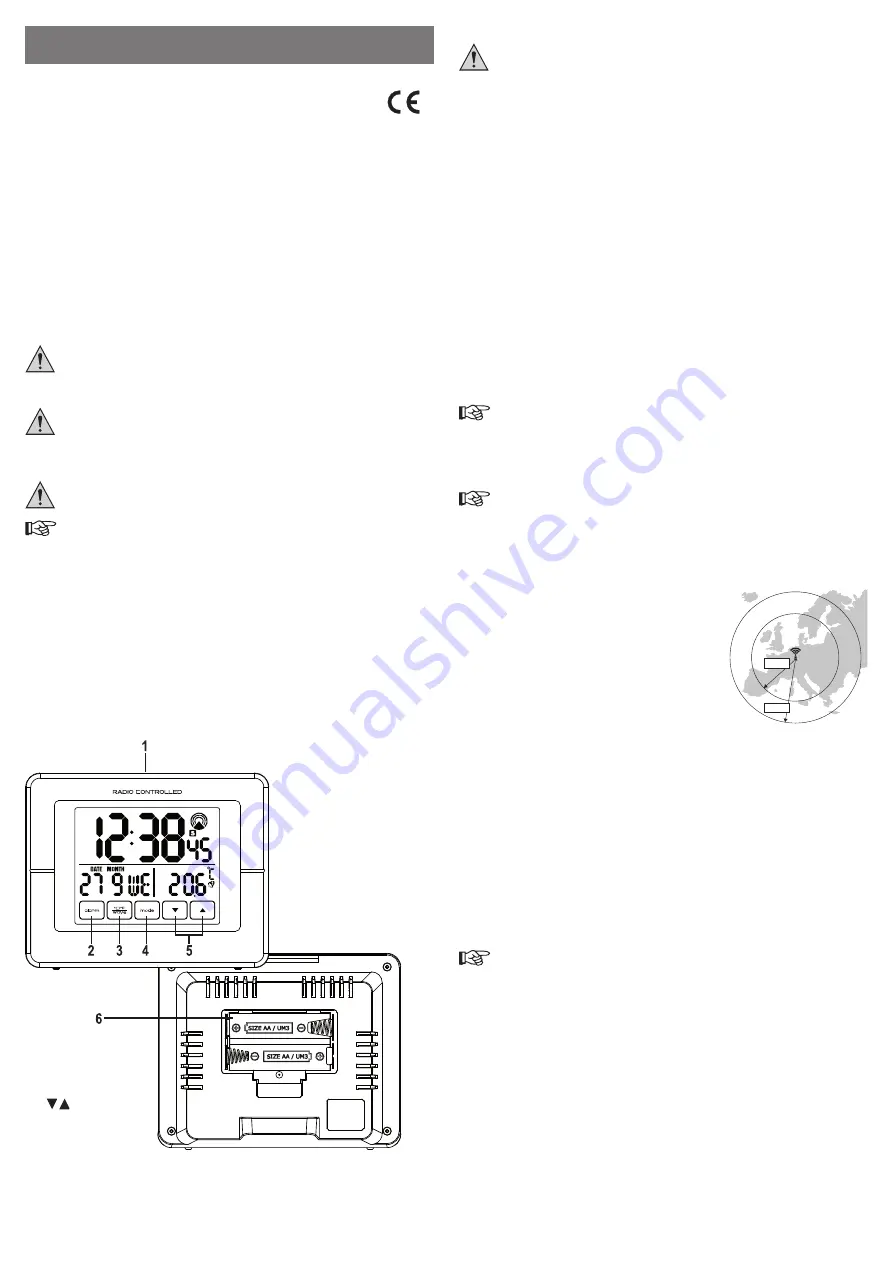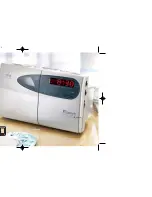
Intended use
The purpose of the radio-controlled clock is to decode the DCF radio signal of the caesium atomic clock in
Braunschweig (Germany), to display the time, date and the external temperature as well as to provide an
alarm function.
The device may be used only indoors. Contact with moisture, for example in bathrooms, must be avoided.
The clock is designed for battery operation only. Do not use any other power supply. The correct battery type
is speci
fi
ed in the “Technical Data” section.
Any use other than that described above is not permitted and can damage the product. In addition, it can lead
to dangers such as short-circuit,
fi
re, etc.
This product complies with the applicable national and European regulations.
All names of companies and products are the trademarks of the respective owners. All rights reserved.
The safety instructions have to be followed without fail.
Safety Instructions
The warranty will be void in the event of damage caused by failure to observe these safety
instructions. We do not assume any liability for any resulting damage.
We shall not accept liability for damage to property or personal injury caused by incorrect
handling or non-compliance with the safety instructions. In such cases, the warranty will
be null and void.
In the operating manual, an exclamation mark inside a triangle indicates important
instructions.
The “hand” symbol indicates special information and advice on operating the device.
• For safety reasons, any unauthorised conversion and/or modi
fi
cation to the product is not permitted.
• Do not expose the product to high temperatures, strong vibrations or heavy mechanical loads.
• Handle the product with care; it can be damaged by impacts, blows, or accidental falls, even from a low
height.
• If you have any doubts about the correct operation, or the safety of the product, please consult a specialist.
• This product is not a toy and must be kept out of the reach of children. Only use the product out of the
reach of children. Small parts of the product or the battery could be swallowed.
• Condensation may form when the product is brought from a cold room into a warm one. Therefore, wait
until it has reached room temperature before using it.
• Do not leave packaging materials unattended. It may become a dangerous plaything for children.
• Please observe the additional safety instructions in the individual chapters of this manual.
Controls and Parts
(1) SNOOZE/LIGHT
button
(2) ALARM
button
(3) °C/°F / WAVE button
(4) MODE
button
(5)
/ button
(6) Battery
compartment
Inserting/Replacing the batteries
Batteries should be kept out of the reach of children.
Make sure that the polarity is correct when inserting the batteries.
Remove the battery, if you are not going to use the device for a while, to prevent damage
from leaking. Leaking or damaged batteries/rechargeable batteries can cause acid burns
upon contact with skin. Thus, you should wear protective gloves when handling dam-
aged batteries/rechargeable batteries.
Keep them out of the reach of children. Do not leave batteries lying around. There is
the risk that the batteries may be swallowed by children or pets. If they are swallowed,
consult a doctor immediately.
Make sure that batteries are not short-circuited or thrown into a
fi
re. There is a risk of
explosion.
Do not recharge normal, non-rechargeable batteries; there is a risk of explosion! Only
charge rechargeable batteries that are intended for this purpose; use a suitable battery
charger.
The batteries should have the same level of charge and be of the same type. Mixing old
and new batteries or mixing different batteries in the device can lead to battery leakage
and thus to damage to the device.
• Open the cover of the battery compartment (6) on the back of the device.
• Insert two new 1.5V mignon batteries (AA) in the battery compartment (6), paying attention to the polarity.
The correct polarity is indicated in the battery compartment.
• Close the battery compartment (6) again.
• The clock now starts searching for the DCF signal and tries to tune in.
• When the display’s contrast fades or when the display light no longer
fl
ashes, the batteries are
fl
at and
need to be replaced as described above.
• To ensure a long battery life, only use alkaline types.
Rechargeable batteries may be used but due to the lower voltage output (rechargeable battery
= 1.2V, standard battery = 1.5V) and the lower capacity, the service life is shorter.
DCF Reception
Immediately after the batteries are inserted, the device makes the
fi
rst attempt to receive the DCF signal.
After a successful DCF reception, the clock is automatically set to the current time.
The recognition and interpretation of the DCF signal can take 3-5 minutes. Do not move the
radio-controlled clock during this time. Do not press any buttons or switches!
Bad reception can occur, for example, by metallised insulated glass, reinforced concrete
buildings, coated special wallpapers, proximity to electronic devices, or installation in cellars.
If after 10 minutes the clock has not set the current time, change the location of the radio clock
and press the °C/°F / WAVE (3) button for 3 seconds.
This will start a new reception attempt.
The reception attempt for the daily automatic synchronisation with
1500 km
2000 km
the DCF time is done several times a day. One successful recep-
tion per day is suf
fi
cient to keep the deviation to less than one
second.
The DCF signal is encoded and transmitted via a DCF transmitter
in Main
fl
ingen (near Frankfurt am Main). Its range is up to 1500 km
and, under ideal reception conditions, even up to 2000 km.
Among other things, the DCF signal includes the precise time
(theoretical deviation of 1 second in a million years!) and the date.
Naturally, this also eliminates the hassle of manually setting sum-
mer and winter time.
Installation/Setup
• Install the clock on a level,
fl
at and stable surface.
• Protect valuable furniture surfaces by using an appropriate underlay; otherwise, it may cause scratches.
DCF Time Adjustment
• After the batteries have been inserted, the clock searches automatically for the DCF signal. This is indi-
cated by the
fl
ashing DCF symbol in the upper right of the display.
• Normally, the synchronisation process is completed within a few minutes.
• As soon as the DCF signal is decoded, the DCF tower icon will appear continuously and the current time
and date are shown in the display.
• In normal operation, the clock makes a reception attempt 10 times during the day. If the signal is not
received, the DCF icon disappears.
• To start a manual reception attempt, press the button °C/°F / WAVE (3) for 3 seconds.
If there is interference with the reception of the DCF signal, try to
fi
nd a new location and/or leave
the clock near a window overnight.
At night the reception is better, so the watch is normally synchronized the next morning.
The “S” indicator under the DCF symbol in the display is the symbol indicating summertime.
O P E R A T I N G I N S T R U C T I O N S www.conrad.com
Radio-controlled Clock with
Touch Display RC 246
Item no. 39 32 42
Version 02/13


























